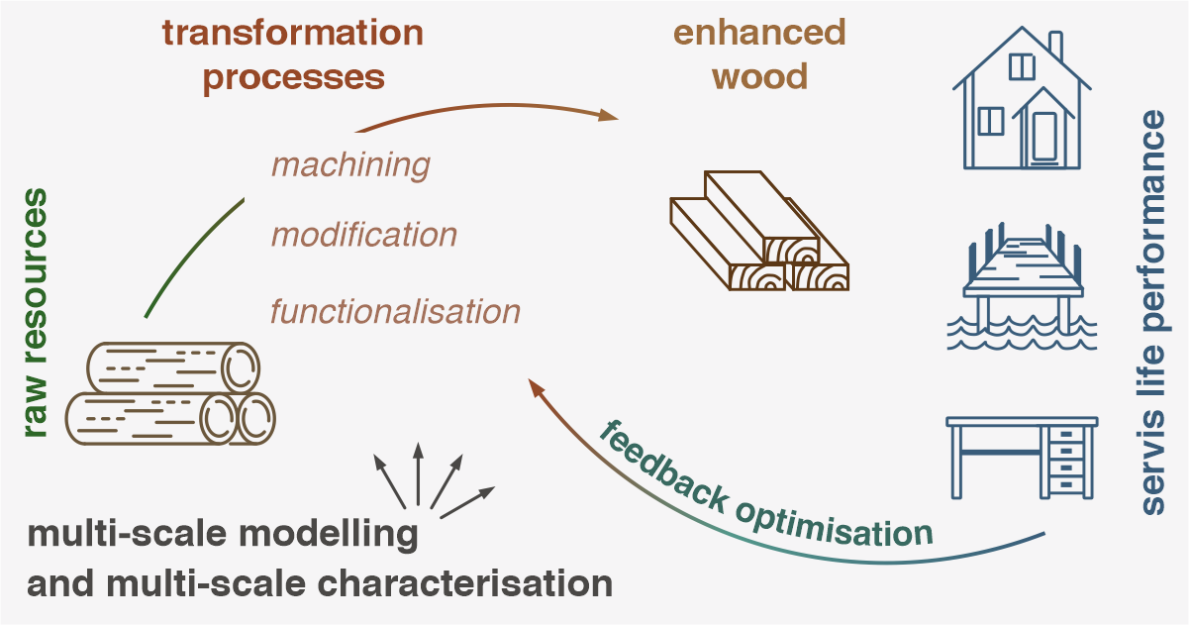Transformation of Wood after Processing and Modification
A special issue of Forests (ISSN 1999-4907). This special issue belongs to the section "Wood Science and Forest Products".
Deadline for manuscript submissions: 28 February 2025 | Viewed by 2137

Special Issue Editors
Interests: wood science; surface characterisation; adhesion; wood anatomy; mechanical properties; chemical properties; surface spectrophotometry; bioderived advanced materials; timber-based products; material properties
Interests: engineered living materials; bioinspired materials design; wood modification and functionalization; multiscale characterization; service life performance
Special Issues, Collections and Topics in MDPI journals
Interests: wood structure; wood composition; wood characterisation; wood conservation; wood preservation; waterlogged archaeological wood; structure–function relationships; wood decay; organosilicons in wood conservation; wood modification
Special Issues, Collections and Topics in MDPI journals
Special Issue Information
Dear Colleagues,
Wood plays a crucial role in tackling climate change as it acts as a carbon sink, sequestering carbon dioxide from the atmosphere, and the field of wood processing and modification is currently undergoing dynamic changes, marked by continuous advancement, innovation, and evolving techniques. This Special Issue aims to explore the dynamic transformations that wood undergoes post-processing and -modification, shedding light on the multifaceted alterations in its properties and characteristics. From novel processing methods enhancing wood's structural integrity to innovative modification techniques improving its durability and functionality, this Special Issue seeks to unravel the dynamic nature of wood materials in response to changing methodologies and technologies. By compiling cutting-edge research and insights, the aim is to provide a comprehensive understanding of the dynamic changes shaping the landscape of wood processing and modification.
Potential Topics:
- Changes in wood properties post-processing and -modification;
- Advanced techniques in wood processing for enhanced outcomes;
- Innovative wood modification methods for improved characteristics;
- Responses of wood to novel processing technologies;
- Improving wood durability through innovative modification approaches;
- Adapting wood properties to meet evolving industry demands;
- Alterations in wood structure and composition following processing and modification;
- Harnessing transformations in wood for sustainable manufacturing practices;
- Optimizing wood processing and modification techniques.
Dr. Athanasios Dimitriou
Dr. Anna Sandak
Dr. Magdalena Broda
Guest Editors
Manuscript Submission Information
Manuscripts should be submitted online at www.mdpi.com by registering and logging in to this website. Once you are registered, click here to go to the submission form. Manuscripts can be submitted until the deadline. All submissions that pass pre-check are peer-reviewed. Accepted papers will be published continuously in the journal (as soon as accepted) and will be listed together on the special issue website. Research articles, review articles as well as short communications are invited. For planned papers, a title and short abstract (about 100 words) can be sent to the Editorial Office for announcement on this website.
Submitted manuscripts should not have been published previously, nor be under consideration for publication elsewhere (except conference proceedings papers). All manuscripts are thoroughly refereed through a single-blind peer-review process. A guide for authors and other relevant information for submission of manuscripts is available on the Instructions for Authors page. Forests is an international peer-reviewed open access monthly journal published by MDPI.
Please visit the Instructions for Authors page before submitting a manuscript. The Article Processing Charge (APC) for publication in this open access journal is 2600 CHF (Swiss Francs). Submitted papers should be well formatted and use good English. Authors may use MDPI's English editing service prior to publication or during author revisions.
Keywords
- wood processing
- wood modification
- transformation changes
- durability
- wood properties
- structural integrity
Benefits of Publishing in a Special Issue
- Ease of navigation: Grouping papers by topic helps scholars navigate broad scope journals more efficiently.
- Greater discoverability: Special Issues support the reach and impact of scientific research. Articles in Special Issues are more discoverable and cited more frequently.
- Expansion of research network: Special Issues facilitate connections among authors, fostering scientific collaborations.
- External promotion: Articles in Special Issues are often promoted through the journal's social media, increasing their visibility.
- e-Book format: Special Issues with more than 10 articles can be published as dedicated e-books, ensuring wide and rapid dissemination.
Further information on MDPI's Special Issue polices can be found here.







